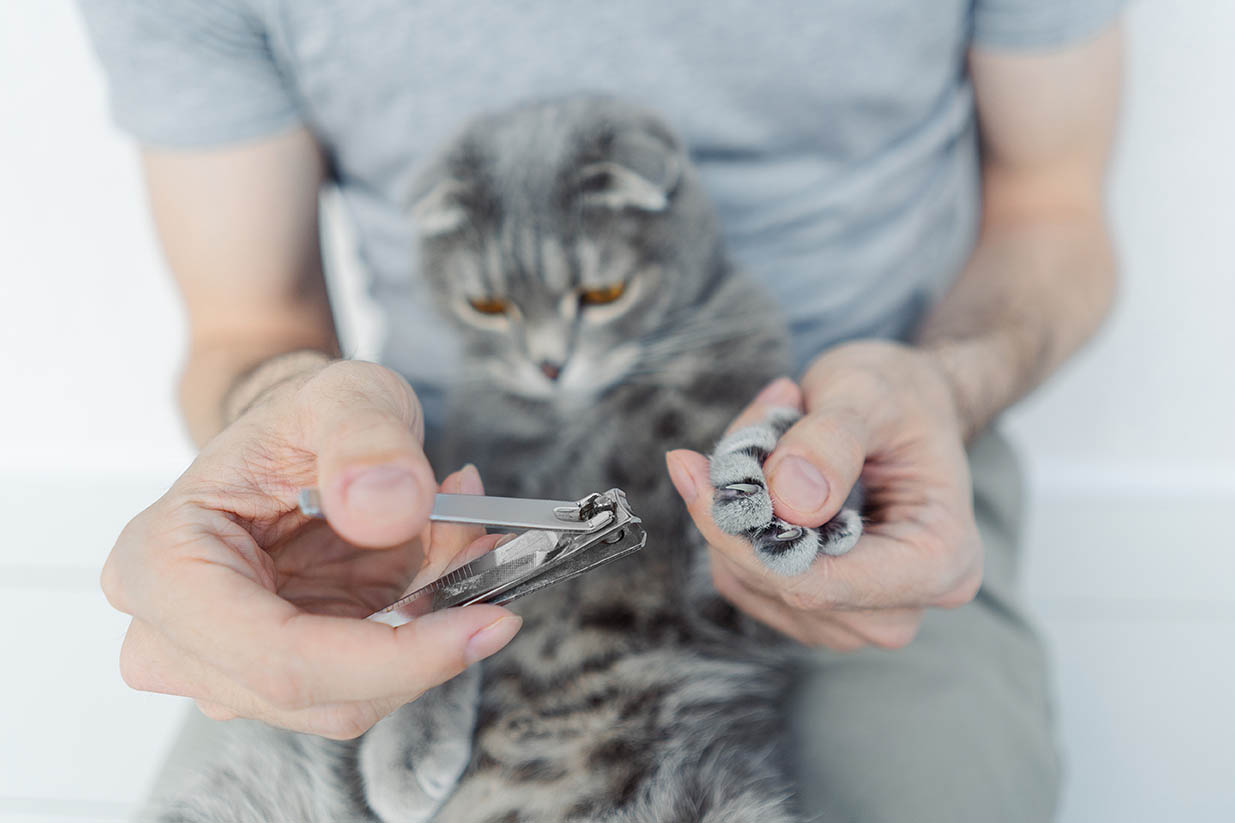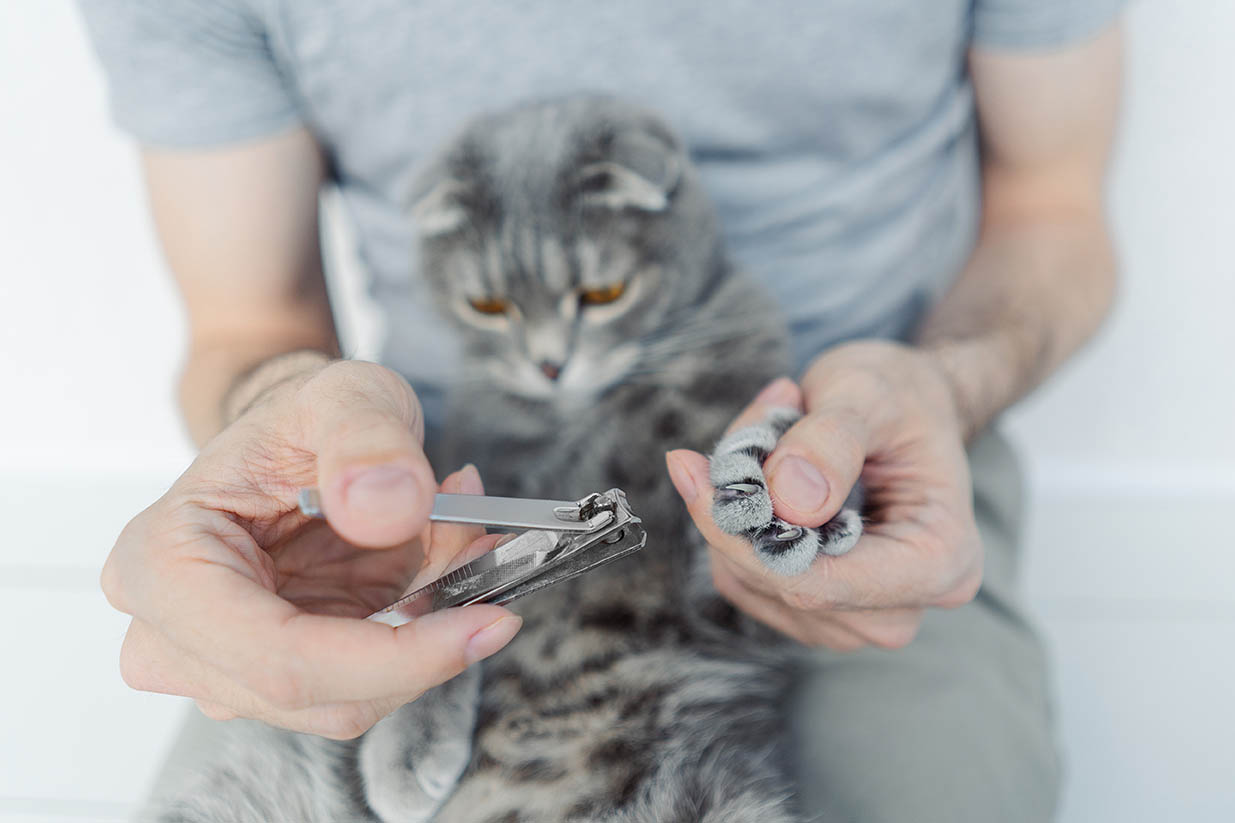
How to Get Your Cat Comfortable With Nail Cutting
Trimming a cat’s nails requires patience, confidence, and training. Here are some tips to help you get started:
Start by massaging a paw pad and pressing on the nail gently to extend it. Remember to keep the nail clippers away from the pink part of the nail, called the quick, which contains nerves and blood vessels. Cutting into this area will cause pain and bleeding.
Getting Started
To make nail clipping less stressful for both of you, introduce your cat to the idea well before it’s time to actually trim her nails. When she’s at ease, perhaps sitting on the sofa with you or lying down with a stuffed animal on her bed, gently touch her paw pads with your fingertips, and eventually, take one of her nails in your hand. Press hard enough to extend the nail and see its sharp tip, but not so hard that she feels pain or discomfort. If she tolerates this, give her a treat and leave her alone to get used to having her paws handled.
Next, find a quiet area and sit your cat on a chair or other comfortable surface. She may be more willing to have her paws clipped if she’s in a calm, sleepy state, so try to do it when she’s already relaxed and even a little groggy. If you’re not experienced with nail trimming, try to get a friend or family member to help you. Having 2 people, 1 to hold and the other to clip, works very well for many cats as long as they can work comfortably together. On a table or counter, one person can restrain the cat using a towel or blanket and a firm back-of-the-neck grip, while the other clips.
When clipping, never cut the quick, the pink portion of the nail that contains nerves and blood vessels. Cutting the quick is painful for your cat and can cause bleeding, so always cut away from the quick, not toward it. If you accidentally clip the quick, apply a small dab of styptic powder to stop the bleeding.
Try to only trim a couple of the cat’s nails at a time, to avoid overstimulating her and making her more tense. Also, it’s easier for you to make mistakes when you’re tense, so it’s important that you remain calm and breathe deeply. If the cat resists and becomes agitated or frightened, it may be best to leave the job to a professional. You can always ask your veterinarian or a groomer for tips to help you learn how to trim the cat’s nails at home.
Choosing the Right Tools
When it comes to clipping a cat’s nails, a pair of sharp, high-quality scissors is the simplest tool for the job. However, many veterinarians and vet techs use pliers-like clippers that have a sliding “guillotine” blade that is easier to position over the nail to trim. In a pinch, human nail clippers are also suitable for cutting cats’ nails, but they must be sharp to avoid hurting the animal and possibly causing it to bleed or split.
Before you start trimming, it is a good idea to expose the claw. Cats’ nails naturally retract, but if you squeeze them gently, the claw should pop out, and you should be able to see the pink area of the nail (called the quick) where blood vessels and nerves are located. Cutting a nail too close to the quick can cause bleeding and pain, so it is important to only cut the white part of the nail.
Once the claw is exposed, try to find a comfortable resting position for your cat to hold it in. Many cats like lying down in a lap, so if possible, sit your pet down on your chest or in the crook of your arm. Alternatively, you can rest the cat on a table or padded ironing board. If you have a helper, they can support the pet on one side while you work on the other.
As you get the cat in position, start with a single paw. It’s better to do a few nails at a time, rather than trying to tackle the entire set all at once. This will reduce your stress and the risk of accidentally cutting into the quick. Plus, you can reward your pet with a treat after each snip for their cooperation.
Once you’ve positioned the paw, gently clip just the tip of the nail. Then release the paw and give your pet a treat or a scratch. If your cat seems relaxed, you can move onto another paw and continue this process until all the nails are trimmed. If your cat becomes restless, it’s okay to stop and resume the process at a later time.
Getting Your Cat Comfortable
A good nail trim takes time and patience, but most cats eventually get used to it. When you’re ready to start, sit your cat in a comfortable chair in a quiet room. Avoid distracting noises and keep the sessions short; many cats will only tolerate a few nails at a time. If your cat becomes agitated, stop and try again in a few days. Reward your pet with a treat after each session to reinforce the process.
With your cat seated, massage the pads of one of the feet and give her a treat. Repeat this for the other three paws, making sure you get to each claw before it retracts. If your kitty becomes squirmy, gently wrap her in a towel to keep her still.
When you’re ready to cut, begin by holding your cat in the crook of your arm and gently gripping one of the paws with your other hand. Press down on the pad and top of the toe to extend the claw, then position your clippers just in front of it. You’ll want to make sure the clippers are perpendicular to the nail, not angled, to prevent them from cutting into the quick, which holds nerves and blood vessels.
If you accidentally clip into the quick, it may bleed. Apply styptic powder (available at any pet supply store) to the spot of bleeding to help stop it quickly. You can also use flour or corn starch in a pinch.
If you’re having difficulty getting your kitty to cooperate, ask for help from a friend or family member who can hold the cat and distract her while you cut. If you can’t find anyone willing to help, a well-placed distraction like a favorite toy or treat may be enough to keep her interested and calm. Just be sure your cat isn’t so distracted that she starts to chew on her paw pads or lick her toenails, which can cause pain and bleeding. Once you’ve finished with one paw, reward your cat for her cooperation with a special treat or cuddles.
Making the Cut
When you are ready to cut, find a quiet spot with your cat, away from distractions and noises. Make sure you have a towel for your pet to rest their paw on and some treats or toys to reward them for their cooperation. It is important to start with just one or two nails at a time, so you can get them used to the process and be less stressed. If your pet becomes agitated or upset during the nail trim, stop the session and try again later. Never punish your pet for not cooperating, this will only make the experience worse. If you are still struggling to get your cat comfortable with nail clipping, talk to your veterinarian or groomer for help.
To begin, gently press your cat’s paw to extend the claw. Then use the clippers to carefully trim off the tip of the nail, just above where it curves or hooks downward. Be sure you are not cutting into the pink part of the nail, called the quick. This area contains nerves and blood vessels and if you cut into it, the nail will bleed. If you accidentally cut into the quick, firmly apply some styptic powder or a clotting stick to stop the bleeding.
After completing each nail, firmly reward your cat with a treat, playtime or petting session to end the nail trimming on a positive note. Eventually, your cat will learn to tolerate the nail trims, making it easier for you to do them on a regular basis.
Just like the nails on human hands, cats’ claws need to be trimmed regularly for health and safety reasons. When left unattended, your kitty’s claws will grow too long and cause damage to furniture and skin. Cutting a cat’s nails is not the most pleasant task, but with some preparation, patience and trust, it can be done safely at home. For more tips on nail trimming, visit your veterinarian or groomer for a tutorial. They can also show you how to hold your kitty while getting them used to having their paws handled.






